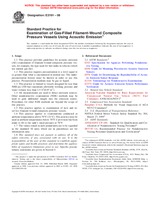Potrebujeme váš súhlas na využitie jednotlivých dát, aby sa vám okrem iného mohli ukazovať informácie týkajúce sa vašich záujmov. Súhlas udelíte kliknutím na tlačidlo „OK“.
ASTM E2191-08
Standard Practice for Examination of Gas-Filled Filament-Wound Composite Pressure Vessels Using Acoustic Emission
Automaticky preložený názov:
Štandardné praktiky pre Vyšetrovanie plynom plnených navíjaných vlákien Composite tlakových nádobách s využitím akustickej emisie
NORMA vydaná dňa 15.2.2008
Informácie o norme:
Označenie normy: ASTM E2191-08
Poznámka: NEPLATNÁ
Dátum vydania normy: 15.2.2008
Kód tovaru: NS-44607
Počet strán: 8
Približná hmotnosť: 24 g (0.05 libier)
Krajina: Americká technická norma
Kategória: Technické normy ASTM
Anotácia textu normy ASTM E2191-08 :
Keywords:
acoustic emission, composite gas cylinders, composite pressure vessel, flaws, gas pressure vessels, NGV tanks, Acoustic emission (AE) testing--metals/metallic materials, Composite pressure vessels, Filament-wound pressure vessels, Gas cylinders, Gas pressure systems/applications, Industrial0 metals/alloys, Pressure vessels, ICS Number Code 17.140.01 (Acoustic measurements and noise abatement in general), 23.020.300
Doplňujúce informácie
| Significance and Use | ||||||||||||||||||
| p>Due to safety considerations, the Compressed Gas
Association (CGA) and others have produced guidelines which address
in-service inspection of NGV fuel containers (see 2.2-2.4). AE
examination is listed as an alternative to the minimum three-year
visual examination which generally requires that the container be
removed from the vehicle to expose the entire container surface.
The AE method allows “in-situ” examination
of the container.
Slow-fill pressurization must proceed at flow rates that do not produce background noise from flow of the pressurizing medium. Acoustic emission data are recorded throughout a pressurization range (that is, 50 % to 100 % of AE examination pressure). Fast-fill pressurization can be used if hold periods are provided. Acoustic emission data are recorded only during the hold periods. Note 1—Fast-fill pressurization is less appropriate for carbon (or graphite) composites due to the lower sensitivity of carbon fibers to stress rupture compared to other fibers. Background noise above the threshold will contaminate the AE data and render them useless. Users must be aware of the following common causes of background noise: high fill rate (measurable flow noise); mechanical contact with the vessel by objects; electromagnetic interference (EMI) and radio frequency interference (RFI) from nearby broadcasting facilities and from other sources; leaks at pipe or hose connections and airborne particles, insects, rain and snow. This practice should not be used if background noise cannot be eliminated or controlled. 5.2 Sensitivity is influenced by factors that affect elastic wave propagation, sensor coupling and signal processor settings. 5.3 It is possible to measure AE from AE sources that cannot be verified by other NDE methods. |
||||||||||||||||||
| 1. Scope | ||||||||||||||||||
|
1.1 This practice provides guidelines for acoustic emission (AE) examination of filament-wound composite pressure vessels, for example, the type used for fuel tanks in vehicles which use natural gas fuel. 1.2 This practice requires pressurization to a level equal to or greater than what is encountered in normal use. The tanks' pressurization history must be known in order to use this practice. Pressurization medium may be gas or liquid. 1.3 This practice is limited to vessels designed for less than 5000 psi (340 bar) maximum allowable working pressure and water volume less than 2.5 ft3 (0.07 m3). 1.4 AE measurements are used to detect emission sources. Other nondestructive examination (NDE) methods may be used to gain additional insight into the emission source. Procedures for other NDE methods are beyond the scope of this practice. 1.5 This practice applies to examination of new and in-service filament-wound composite pressure vessels. 1.6 This practice applies to examinations conducted at ambient temperatures above 70°F (21°C). This practice may be used at ambient temperatures below 70°F if provision has been made to fill to the tank's rated pressure at 70°F. 1.7 The values stated in inch-pound units are to be regarded as the standard. SI units which are in parentheses are for information only. 1.8 This standard does not purport to address all of the safety concerns, if any, associated with its use. It is the responsibility of the user of this standard to establish appropriate safety and health practices and determine the applicability of regulatory limitations prior to use. Specific precautionary statements are given in Section 8. |
||||||||||||||||||
| 2. Referenced Documents | ||||||||||||||||||
|




 Cookies
Cookies
